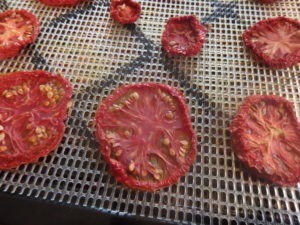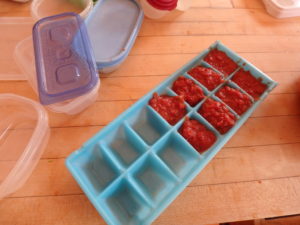Tomatoes: Getting the Best from Your Harvest
This is my favorite time of the year. Tomato time. Tomato sandwiches for breakfast and lunch, Tomato, basil and cucumber salads with dinner. Tomatoes in stir fries. Tomatoes going in the freezer, dehydrator and jars of sauce. Oh my, I do love my tomatoes. I grew 35 plants this year, as I usually do.
Many gardeners complain that blights are reducing their harvests. It’s true that 30 years ago we had little blight. We covered our plants against the frost, and they kept on producing until October. Now tomato leaves turn yellow and brown in July, and by August many plants are pretty much bare of leaves. Why, people ask, do the early blossoms produce fruits, but then the plants just stop producing?
I don’t know all the reasons. I do know that most common tomato diseases are caused by soil-borne fungi that winter-over, coming back year after year. You can minimize the problems by rotating your tomato patch each year, or by planting in a new garden space that was lawn. Usually a new garden in full sun will have few problems, but in the following years, the blight will find your tomatoes.
I have had a good, but not perfect tomato season. I spaced my plants farther apart than I have done in the past, centering them 30 inches or more apart. I planted in the sunniest part of the garden. I cut off diseased branches early and often. And Mother Nature cooperated: June and July were relatively hot and sunny, with low humidity. I had to water early on, but diseases were inhibited by the weather. But now, in August, humidity is high and rain is common. Sigh. My tomatoes are getting blight.
So what do I do with the fruit from 35 plants? For starters I should explain that the trees around my garden have gotten bigger every year, and now my garden only gets sunshine from around 10am to 5pm. That’s considered full sun, but 12 hours is a lot better for production.
The easiest, quickest way to save tomatoes is to freeze them whole for winter. Wash them, make sure they are dry, and put them in gallon freezer-rated zipper bags. I suck the air out of the bags with an ordinary drinking straw. The frozen tomatoes can be used in soups and stews just like canned tomatoes. If you wish to remove the skins, just run the frozen tomato under a stream of hot water and rub off the skin.
Tomatoes also store well if you dry them in a dehydrator. I plant 6 or more Sun Gold cherry tomatoes each year that produce a lot of fruit. I cut them in half and place them on the racks of a dehydrator and dry them at 130 degrees for 18 hours or so. When they are dry I stuff them into quart zipper bags and keep them in the freezer, though freezing is not really needed. I use the dried nuggets of summer in soups, stews and stir fries. I have even put them in winter sandwiches.
You can also dry full-sized tomatoes. Slice them about 3/8 of an inch thick and place them in a dehydrator. I have two kinds of dryer: the Excalibur, a $300 deluxe model that blows warm air sideways equally over all 8 trays, and the NESCO American Harvester, a serviceable machine that pushes air up or down through a stack of trays.
The downside to the NESCO model is that you must rotate the trays to get equal drying. And it uses 1000 watts of energy per hour, and the Excalibur uses only 660 watts. Still, at about $125 for the basic machine, it is more affordable.
A sandwich is not really a sandwich, for me, without slices of tomato. One way to save slices of tomato for winter use is to roast them. I do so in the oven at low heat until they are caramelized and soft, not tough and dry. Then I place them in zipper bags and freeze them – but just one layer of tomatoes per bag. When I crave a tomato in my sandwich, I pull out a few slices and heat in my toaster oven until warm. Not a fresh tomato, but better than most sold in the grocery store in January.
I also make tomato paste. Lots of paste. I store it by freezing it in ice cube trays, and then putting it in zipper bags when frozen. No more half-used cans of purchased paste going fuzzy in the fridge for me.
To make paste I use imperfect tomatoes, of which I have plenty. I cut out the bad spots, then core them. I squeeze the cored tomatoes in the sink, which gets rid of most seeds and lots of juice. Then I quarter them and place in a food processor. I puree them, then add to a large enameled iron pot and cook them slowly for hours. I know they are done when I can literally stand up a spoon in the pot. I let it sit all night, uncovered, to cool and lose some more water. In the morning I spoon the paste in the ice cube trays.
Canning tomatoes is the old fashioned way. I still put up a few jars of sauce each year, but it’s a lot of work and must be done just right in order to avoid getting sick. Mostly now I make a big batch of sauce and freeze it in plastic freezer containers. But I like seeing jars of canned sauce lined up on a shelf in the pantry- and it connects me to my mom and grandmother.
Henry is the author of 4 gardening books. E-mail him at henry.homeyer@comcast.net. Read his blog posts at https://dailyuv.com/





